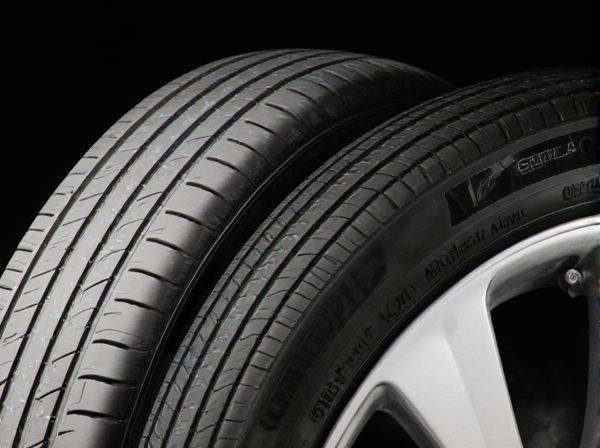
Photo illustration: Whitewall Tire vs Blackwall Tire
Whitewall tires offer a classic, stylish appearance with their distinctive white sidewalls, making them a popular choice for vintage or custom vehicles. Blackwall tires provide a sleek, modern look and often require less maintenance since they don't show dirt or scuffs as easily. Your decision between whitewall and blackwall tires should balance aesthetic preferences with practical considerations like upkeep and the type of vehicle.
Table of Comparison
| Feature | Whitewall Tire | Blackwall Tire |
|---|---|---|
| Appearance | Classic, vintage look with white sidewalls | Modern, sleek all-black sidewalls |
| Usage | Often used on classic and antique cars | Common on most modern vehicles |
| Maintenance | Requires frequent cleaning to maintain whitewalls | Low maintenance; hides dirt and brake dust better |
| Cost | Generally more expensive due to design | Typically more affordable and widely available |
| Durability | Same rubber composition; no significant difference | Same rubber composition; no significant difference |
| Market Availability | Limited to specialty and vintage tire suppliers | Widely available from most tire manufacturers |
Introduction to Whitewall and Blackwall Tires
Whitewall tires feature a distinctive white stripe or sidewall, originally designed for aesthetic appeal and often associated with classic and vintage vehicles. Blackwall tires, in contrast, have uniformly black sidewalls, offering a sleek, modern look that emphasizes durability and a performance-oriented style. Choosing between whitewall and blackwall tires depends on vehicle design preferences and the desired visual impact.
Historical Evolution of Tire Sidewalls
Whitewall tires originated in the early 20th century, featuring a white rubber stripe that symbolized luxury and automobile elegance during the 1920s and 1930s. Blackwall tires emerged as a practical evolution, gaining popularity post-World War II due to increased durability and reduced maintenance compared to whitewall designs. The shift from aesthetics to performance marked the tire industry's adaptation to changing consumer preferences and advancing rubber technology.
Design and Aesthetic Differences
Whitewall tires feature a distinct white stripe or entire sidewall that creates a classic, vintage look often associated with retro and luxury vehicles, enhancing visual appeal with a clean, contrasting design. Blackwall tires, characterized by their fully black sidewalls, offer a sleek, modern aesthetic that blends seamlessly with most car designs, prioritizing a sportier and understated appearance. The choice between whitewall and blackwall tires significantly impacts a vehicle's overall style, with whitewalls emphasizing nostalgia and elegance while blackwalls contribute to a contemporary, aggressive look.
Performance Comparison: Whitewall vs Blackwall
Whitewall tires and blackwall tires differ primarily in aesthetic design, but performance characteristics such as traction, durability, and handling mostly depend on tire construction and rubber compounds rather than wall color. Blackwall tires often feature more advanced tread technology and materials optimized for improved grip, wear resistance, and overall performance in various driving conditions. Whitewall tires are typically chosen for classic or vintage vehicles where style is prioritized over high-performance metrics.
Popularity and Cultural Impact
Whitewall tires gained peak popularity in the 1940s and 1950s, symbolizing luxury and classic automotive style, especially on vintage cars and hot rods. Blackwall tires dominate modern vehicles due to their sleek, low-maintenance design and association with performance and practicality. The cultural impact of whitewalls remains strong in car restoration and classic car shows, while blackwalls represent contemporary automotive trends and everyday functionality.
Cost and Availability Analysis
Whitewall tires generally cost more than blackwall tires due to their classic design and limited production. Availability of whitewall tires is often restricted to specialty shops and vintage car enthusiasts, whereas blackwall tires are widely stocked by major retailers and available in numerous sizes and brands. The higher price and lower availability of whitewall tires reflect their niche market compared to the mass-produced, budget-friendly blackwall options.
Maintenance and Durability Factors
Whitewall tires require more frequent cleaning and specialized care to maintain their appearance, as dirt and brake dust visibly accumulate on the white sidewalls. Blackwall tires typically offer greater durability due to their uniform rubber composition and less susceptibility to cosmetic damage, making them easier to maintain over time. Choosing blackwall tires can reduce maintenance efforts and extend tire life, especially in harsh driving conditions.
Suitability for Classic vs Modern Vehicles
Whitewall tires are ideal for classic vehicles, enhancing their vintage aesthetic with distinctive white sidewalls that complement retro designs and period-correct restorations. Blackwall tires suit modern vehicles by providing a sleek, minimalist appearance that aligns with contemporary styling while offering better resistance to dirt and wear. Choosing between whitewall and blackwall tires depends on maintaining the vehicle's era-appropriate look and balancing aesthetics with practical durability.
Environmental and Manufacturing Considerations
Whitewall tires require additional paint or coating processes, increasing resource consumption and potential chemical waste during manufacturing. Blackwall tires generally involve simpler production with lower environmental impact due to fewer materials and processing steps. Disposal of whitewall tires can pose challenges as paint layers may hinder recycling efforts, whereas blackwall tires are easier to recycle and repurpose.
Choosing the Right Tire for Your Vehicle
Whitewall tires provide a classic aesthetic popular among vintage car enthusiasts, enhancing your vehicle's visual appeal but may require more frequent cleaning to maintain their look. Blackwall tires offer a robust, modern appearance with easier maintenance and generally better UV resistance, making them suitable for everyday driving and rugged conditions. When choosing the right tire, consider your vehicle's style, driving environment, and maintenance preferences to ensure both performance and visual satisfaction.
 caratoz.com
caratoz.com